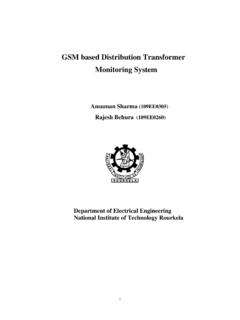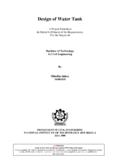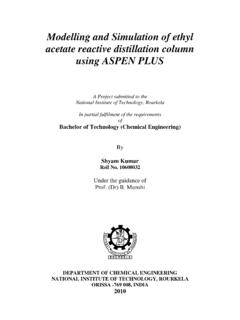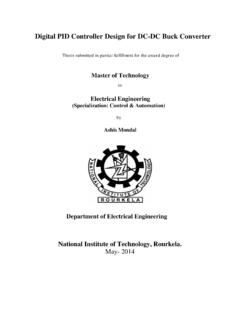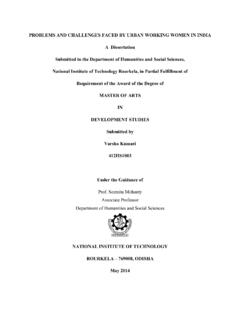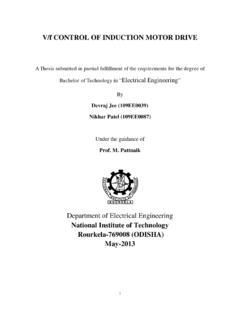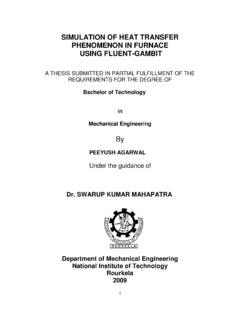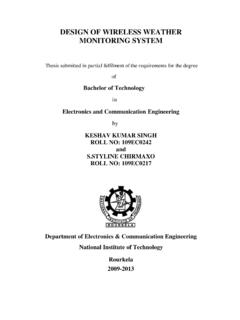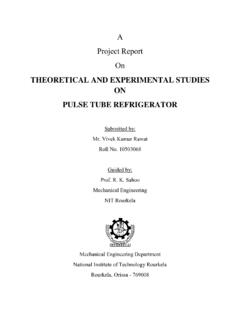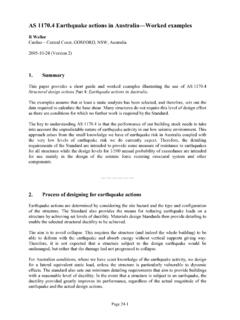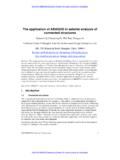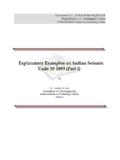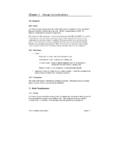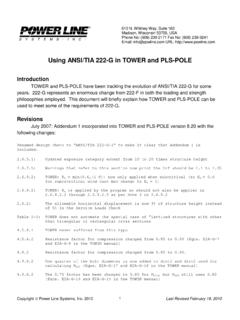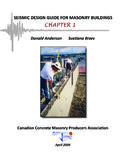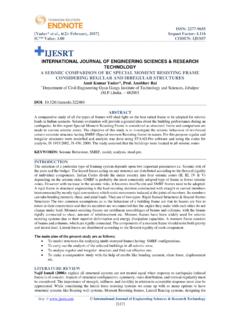Transcription of Computer aided analysis and design of multi …
1 Computer aided analysis and design of multi - storeyed buildings A Project Submitted In Partial Fulfilment of the Requirements For the Degree of Bachelor of Technology In Civil Engineering By Bedabrata Bhattacharjee Roll & Nagender Roll DEPARTMENT OF CIVIL ENGINEERING NATIONAL INSTITUTE OF TECHNOLOGY ROURKELA 2007 Computer aided analysis and design of multi - storeyed buildings A Project Submitted In Partial Fulfilment of the Requirements For the Degree of Bachelor of Technology In Civil Engineering By Bedabrata Bhattacharjee Roll & Nagender Roll Under the guidance of Prof. Mishra DEPARTMENT OF CIVIL ENGINEERING NATIONAL INSTITUTE OF TECHNOLOGY ROURKELA 2007 NATIONAL INSTITUTE OF TECHNOLOGY ROURKELA CERTIFICATE This is to certify that the project entitled Computer aided analysis and design of multi - storeyed buildings submitted by Mr Bedabrata Bhattacharjee [roll no.]
2 10301004] and Mr Nagender [roll no. 10301025] in partial fulfilment of the requirements for the award of bachelor of technology degree in Civil engineering at the National Institute of Technology Rourkela (deemed University) is an authentic work carried out by them under my supervision and guidance. To the best of my knowledge the matter embodied in the project has not been submitted to any other university/institute for the award of any degree or diploma. Date: 01-04-2007 Prof. Mishra Department of Civil Engineering National Institute of Technology Rourkela - 769008 iACKNOWLEDGEMENT We would like to express our profound sense of deepest gratitude to our guide and motivator Prof. Mishra, professor, Civil Engineering Department, National Institute of Technology, Rourkela for his valuable guidance, sympathy and co-operation for providing necessary facilities and sources during the entire period of this project.
3 We wish to convey our sincere gratitude to all the faculties of Civil Engineering Department who have enlightened us during our studies. The facilities and co-operation received from the technical staff of Civil Engineering Department is thankfully acknowledged. We express our thanks to all those who helped us in one way or other. Last, but not least, we would like to thank the authors of various research articles and books that were referred to. Bedabrata Bhattacharjee Roll No. 10301004 Roll No. 10301025 8th semester 8th semester iiCO N T E N T S ChapterNo. Title Page No. CERTIFICATE i ACKNOWLEDGEMENT ii CONTENTS iii ABSTRACT v LIST OF FIGURES vii LIST OF TABLES vii 1 INTRODUCTION 1 2 LOADS CONSIDERED 4 DEAD LOAD 5 IMPOSED LOAD 5 WIND LOAD 5 SEISMIC LOAD 7 3
4 WORKING WITH 10 INPUT GENERATION 11 TYPES OF STRUCTURE 11 GENERATION OF THE STRUCTURE 12 MATERIAL CONSTANTS 12 SUPPORTS 13 LOADS 13 SECTION TYPES FOR CONCRETE design 16 design PARAMETERS 16 BEAM design 16 COLUMN design 17 design OPERATIONS 18 GENERAL COMMENTS 18 POST PROCESSING FACILITIES 19 4 analysis OF G+21 RCC FRAMED building 21 USING
5 PHYSICAL PARAMETERS OF building 23 GENERATION OF MEMBER PROPERTY 24 SUPPORTS 24 MATERIALS FOR THE STRUCTURE 25 LOADING 25 5 design OF G+21 RCC FRAMED building 34 USING iii ChapterNo. Title Page No. 6 INPUT COMMAND FILE 36 7 analysis AND design RESULTS 42 BEAM NO. 149 design RESULTS 43 COLUMN NO. 3 design RESULTS 46 BEAM NO. 1527 design RESULTS 47 BEAM NO. 2108 design RESULTS 48 COLUMN NO. 1237 design RESULTS 49 COLUMN NO. 2050 design RESULTS 49 8 POST PROCESSING MODE 50 9 CONCLUSION 54 REFERENCE 56 ivABSTRACT The principle objective of this project is to analyse and design a multi - storeyed building [G + 21 (3 dimensional frame)] using STAAD Pro.
6 The design involves load calculations manually and analyzing the whole structure by STAAD Pro. The design methods used in STAAD-Pro analysis are Limit State design conforming to Indian Standard Code of Practice. features a state-of-the-art user interface, visualization tools, powerful analysis and design engines with advanced finite element and dynamic analysis capabilities. From model generation, analysis and design to visualization and result verification, is the professional s choice. Initially we started with the analysis of simple 2 dimensional frames and manually checked the accuracy of the software with our results. The results proved to be very accurate. We analysed and designed a G + 7 storey building [2-D Frame] initially for all possible load combinations [dead, live, wind and seismic loads]. has a very interactive user interface which allows the users to draw the frame and input the load values and dimensions.
7 Then according to the specified criteria assigned it analyses the structure and designs the members with reinforcement details for RCC frames. We continued with our work with some more multi - storeyed 2-D and 3-D frames under various load combinations. Our final work was the proper analysis and design of a G + 21 3-D RCC frame under various load combinations. We considered a 3-D RCC frame with the dimensions of 4 bays @5m in x-axis and 3 bays @5m in z-axis. The y-axis consisted of G + 21 floors. The total numbers of beams in each floor were 28 and the numbers of columns were 16. The ground floor height was 4m and rest of the 21 floors had a height of structure was subjected to self weight, dead load, live load, wind load and seismic loads under the load case details of The wind load values were generated by considering the given wind intensities at different heights and strictly abiding by the specifications of IS 875.
8 Seismic load calculations were done following IS 1893-2000. The materials were specified and cross-sections of the beam and column members were assigned. The supports at the base of the structure were also specified as fixed. The codes of practise to be followed were also specified for design purpose with other important details. Then was used to analyse the structure and design the members. In the post-processing mode, after completion of the design , we can work on the structure and study the bending moment and shear force values with the vgenerated diagrams. We may also check the deflection of various members under the given loading combinations. The design of the building is dependent upon the minimum requirements as prescribed in the Indian Standard Codes. The minimum requirements pertaining to the structural safety of buildings are being covered by way of laying down minimum design loads which have to be assumed for dead loads, imposed loads, and other external loads, the structure would be required to bear.
9 Strict conformity to loading standards recommended in this code, it is hoped, will ensure the structural safety of the buildings which are being designed. Structure and structural elements were normally designed by Limit State Method. Complicated and high-rise structures need very time taking and cumbersome calculations using conventional manual methods. provides us a fast, efficient, easy to use and accurate platform for analysing and designing structures. viLIST OF FIGURES Figure No. Title Page No. STAAD input file 11 Generation of structure through GUI 12 Member load configuration 14 Plan of the G+21 storey building 22 Elevation of the G+21 storey building 23 Generation of member property 24 Fixing supports of
10 The structure 24 Primary load cases 25 Input window of floor load generator 26 load distribution by trapezoidal method 26 The structure under DL from slab 27 The structure under live load 27 Defining wind load intensities 28 Wind load effect on structure elevation and plan 29 Seismic load definition 32 Structure under seismic load 32 Under combination with wind load 33 Under combination with seismic load 33 GUI showing the analyzing window 33 Input window for design purpose 35
